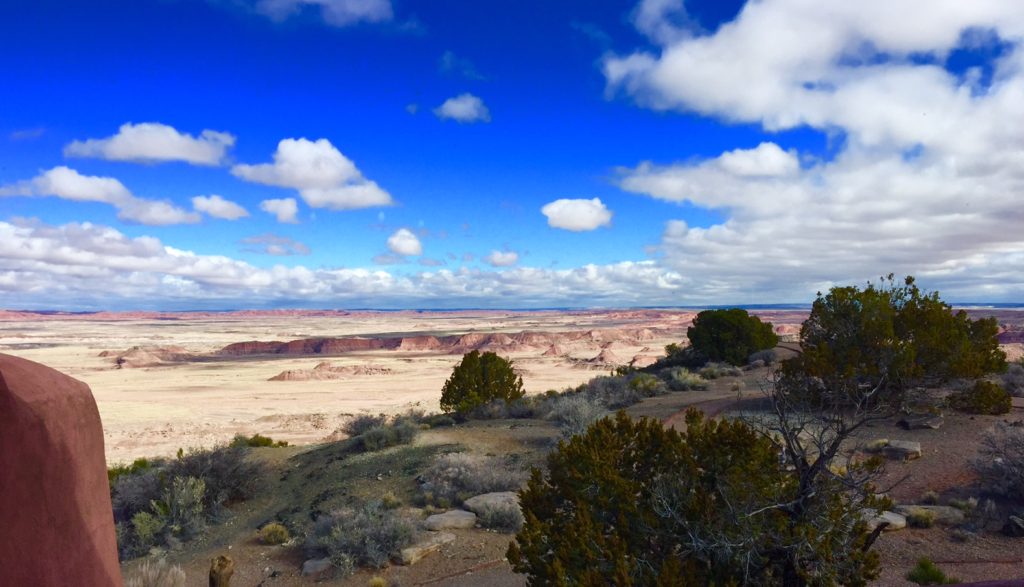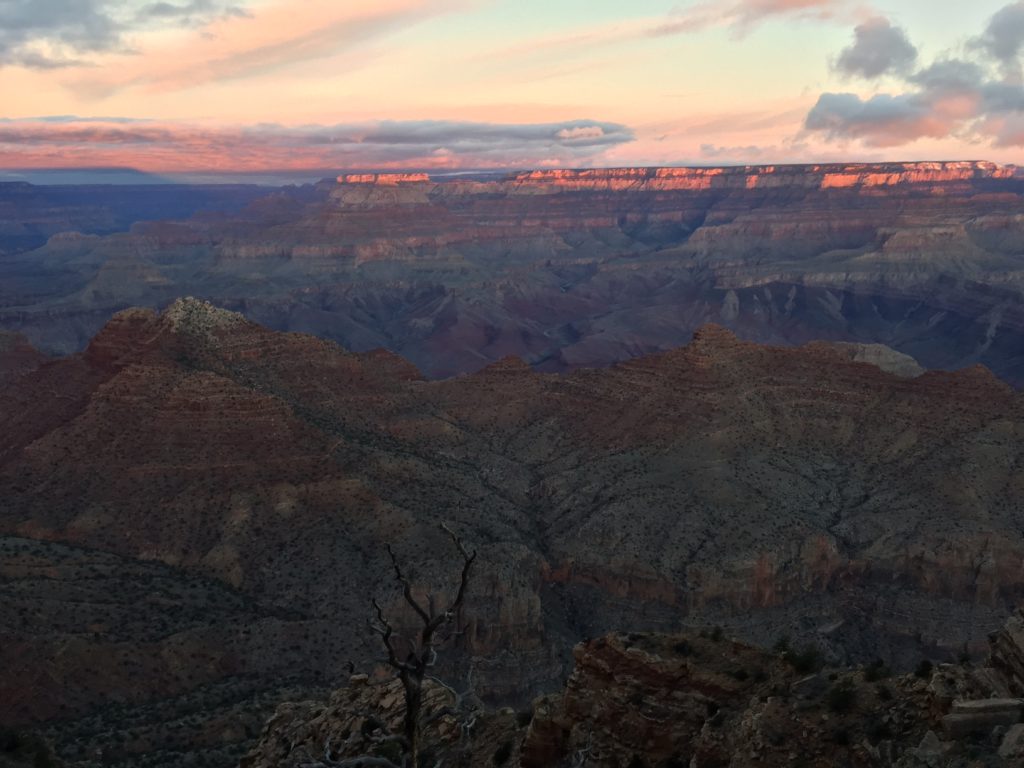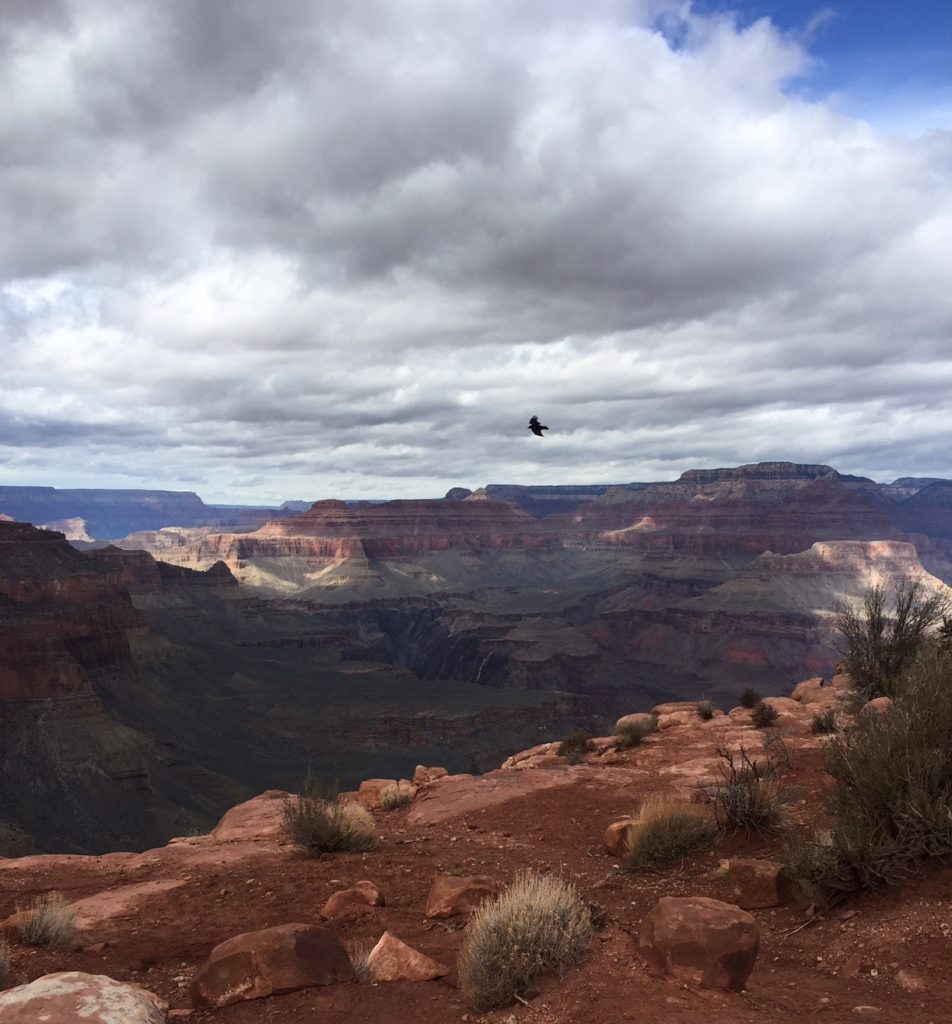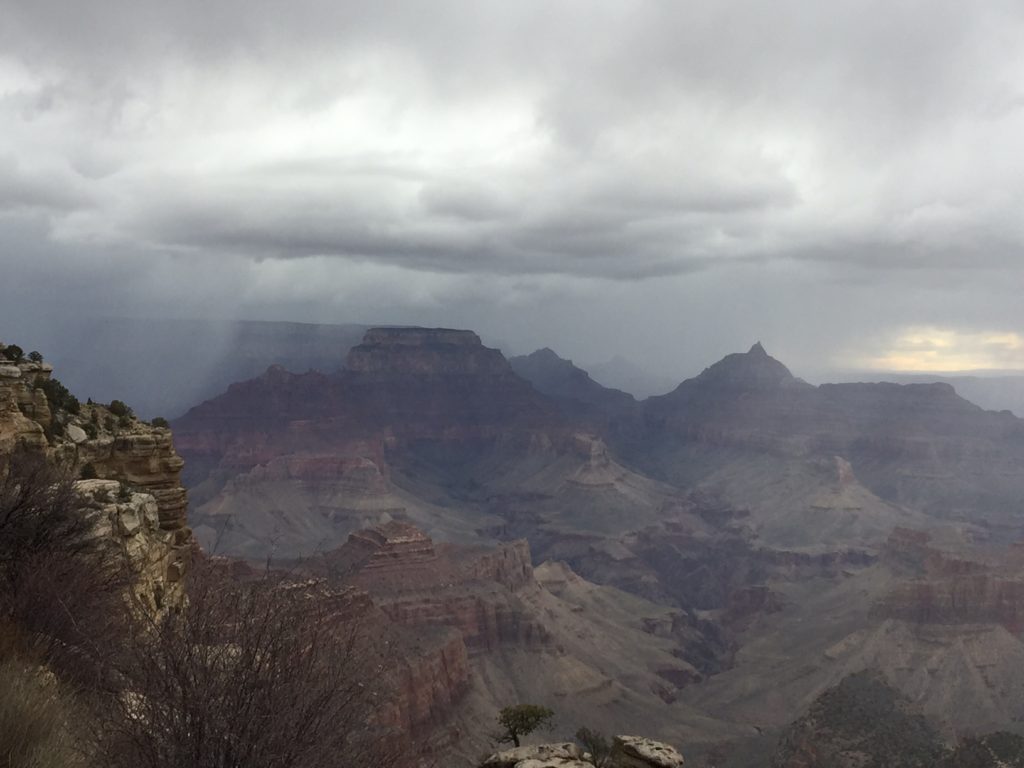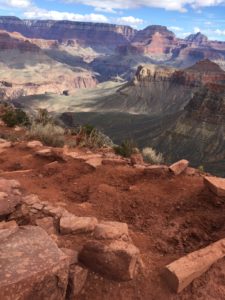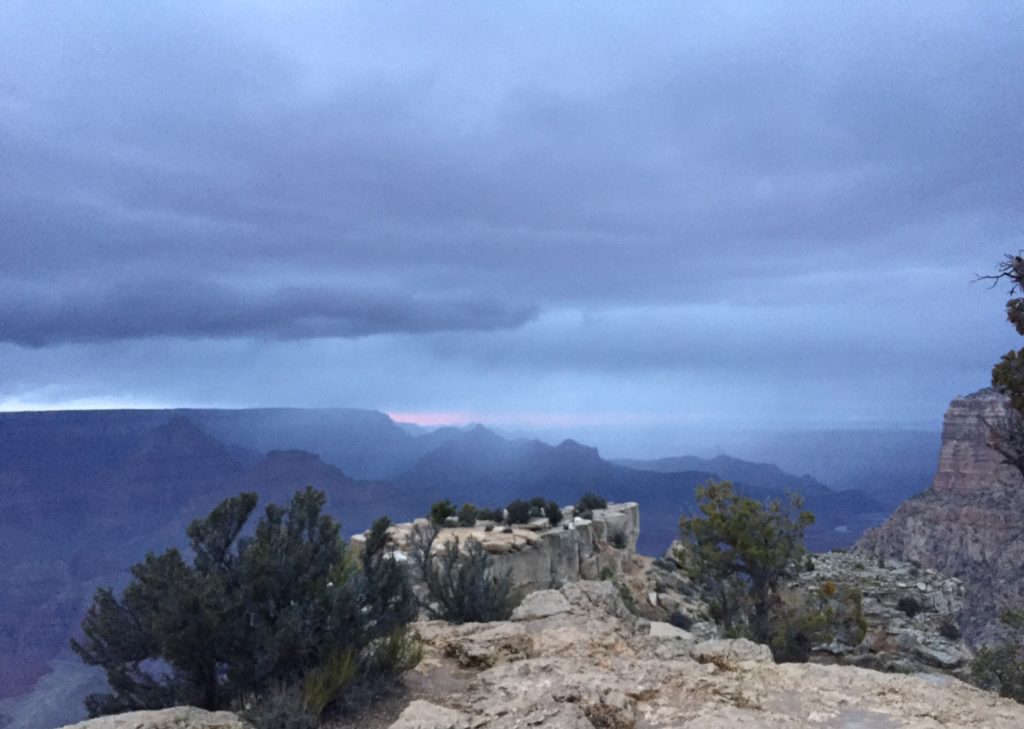The Grand Canyon: of crows and ravens
Such a very small world is familiar, and so much of the map is foreign, personally uncharted – especially when you grow up on a farm in 1970’s Iowa. I remember, as a child, my coloring book with a very simple, colorful picture of a farm on the cover – classic red barn, cyan blue sky, kelly green leaves of a tree, and – orange-brown dirt? I couldn’t understand how such a gaffe would be allowed to pass unedited through whatever publishing process coloring books pass through. Because, as everyone knew, dirt was black. Pitch black. Black as the night of a new moon. Black as the void. The void from which all life springs, all colors grow. Black is the source, the secrets of seeds revealed only there, under it’s protective sheltering wing of soil.
It wasn’t until we moved to Colorado when I was a teenager that I saw farms with coloring book fields. Sun-bleached wheat grew from the water-parched orange-brown rows. I marveled that anything could grow without the rich blackness. I watched the distant blue horizon dream hazy clouds into the reality of blue mountain ranges. I was staggered that this fascinating, foreign land lay only one day’s drive from the 300 acres of the familiar.
The wildlife was similar, but changed, bigger. White-tailed deer were supplanted by larger mule deer, and even larger elk. Fewer foxes, more coyote. I saw my first jackrabbits, so much bolder than the tiny cottontails I knew. And, I saw my first ravens.
I had grown up with crows – gathering in the tops of our elm and maple trees, cawing incessantly, rising as one from the harvested corn fields. I had no stories for crows except as garden and field pests, or nibblers of roadkill skunk and raccoon. Noisy as bluejays and less beautiful to see, I had no love of common crows.
But ravens – ravens startled me with their unexpectedly impressive presence. The first time I saw a raven, I knew it was not a crow. I knew from its size, I knew from its face, and I knew from its voice. While I had expected elk to be more than I had imagined, more majestic than deer, awesome and thrilling as they slowly stepped between tall pines in the high forests…well, I hadn’t thought about ravens being in Colorado. Edgar Allen Poe wasn’t from Colorado, and he was my only reading on ravens. I had no frame of reference. And since I had no frame of reference, I was wide open to my experience. So seeing my first raven surprised me, and expanded my mind. Because it was more than I knew. It was beyond my familiar.
I have since found out that this is the mythology of the raven. Smart and strong, Raven is a character of metamorphosis. To the Hopi, Navajo, and Zuni of the Southwest, Raven has trickster energy, a bearer of magic and messages from beyond time. Raven flew out of the great darkness carrying the stolen sun and so brought the light, transforming the world. In Norse myths, Odin had two ravens named Thought and Memory who flew over the earth and brought information back to him. Like Aquarius of the zodiac, Raven shares knowledge that comes from elsewhere, that pours like water and illuminates like lightning in the night.
I hadn’t seen a raven in years. But the birth of my second grandbaby brought a fortuitous mistake of too many helpers converging on my daughter’s home on the same weekend. What to do? In Gallup, New Mexico? The answer came to me immediately: take off for the Grand Canyon, of course. I had never been, and it was only a few hours away.
We helpers were like crows, grandparents and aunts and uncles gathering, cawing and restlessly ruffling our feathers as we spied for tasks like dishes and laundry and taking out the trash. We feasted on the sweetness of mama and baby and tiniest big brother on the couch together, then rose like a heavy wave of family helpfulness into the rooms of their home. At times we sat quiet and watchful, contentedly perched together, roosting. But crows know the cultivated fields, and soon we’d be back in the kitchen, cawing out questions of favorite meals and freezer space and Tupperware.
I was sad to go. But as soon as I was headed for the Grand Canyon, I let it go, easily. New Mexico softens its vistas with sage hills and low mesas and rounded mountains; but Arizona is wide, wide open, pushing your vision to the horizon and then up into the endless sky. I flew along in my jeep, rambling through the Painted Desert, discovering forests petrified into jasper and crystal before humans had written words, their hopes and fears and baby’s handprints carved into red stone.
I passed Fort Courage, wasted bottomland filled with old trailers covered in painted aluminum, vinyl siding, plywood, and treaties. Old pickups bleached like bones in this desert sat parked on mismatched tires, tread, no tread, bald like bald-faced lies, American flag snapping in the wind over a yellow dog trotting in dust.
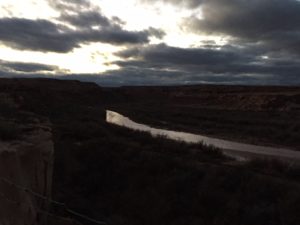 I got a room at the Cameron Trading Post, circa 1916, where you can still walk into the deep Southwest, buy a bag of Bluebird flour, some jerky, coffee, and a blanket woven by an Indian, sold by an Indian. The trading post still holds the south bank of the Little Colorado River, and I watched it wind its muddy way west under the deepening sky to join the canyon I would see tomorrow.
I got a room at the Cameron Trading Post, circa 1916, where you can still walk into the deep Southwest, buy a bag of Bluebird flour, some jerky, coffee, and a blanket woven by an Indian, sold by an Indian. The trading post still holds the south bank of the Little Colorado River, and I watched it wind its muddy way west under the deepening sky to join the canyon I would see tomorrow.
I woke in the darkness, black sky sharing the tiniest stars like secrets over an unseen desert. I drove up scrubby foothills where, at the top, elk and deer wander through pine forests standing in dark pools of melted snow, cold February evergreen swamps on mesas of rocky clay and limestone that cannot soak it all in, and neither can I.
When I rose over a hill and saw my first pre-dawn view of the Grand Canyon, I laughed out loud, goofy raw croaks of surprise, delight, and recognition of something beyond time, all vying to be expressed first, immediately, forever. I parked at the overlook and walked out to the edge to watch the sun rise. A few other people stood nearby, facing east, waiting for the sun. I faced west – waiting for the effect of the sun on the vast canyon itself. As I stood alone, sensing the shifting light before dawn, I had the most unexpected feeling: contentment. I felt as open and quiet as the distances before me, while I stood in the chill morning breeze and watched pink tinge the clouds and then the highest ridges of stone, followed by golden orange, and finally the yellow light of sunrise. Silently, two ravens rose with the sun, up from the darkness of the cliffs and canyons below, their feathers like fingers lifting the light into the sky.
The sun danced with clouds through the whole day, light and shadow, warm in the sun, chilly in shade. I hiked down into the earth for hours, following long thin paths along the yellow, orange and magenta rock walls, colored like the sunrise. As I stopped for water and rest, always the ravens circled by twos, circling each other before lifting or drifting to the next island of earth in this ocean of air and time.
As evening approached, the clouds thickened, rolling over the immensity of the canyon. The sun set behind heavy rains rolling across the great depths, across the blackness of the void. The source. The blackness from which all light and life came, safe under the protective, sheltering wing of that now-familiar trickster, Raven. I stood in the rain, in the dark, on the edge of the Grand Canyon, in a space circled by thought and memory.
red mud trail
sliding down switchbacks
into depths
I have yet to knowthis clay and sand
this earth and snow
today the ground
beneath my feet
is liquid pooling
every step
will suck me down
to the old world beneath
through the hole in the sky
at the bottom of the canyoncompelled to reach
my hands in
to this earth’s lifeblood
stain me red
and so it does
ochre of birth and death
across so many ages
my palms
now touch the sacred walls
of life
and from my fingers
forms a dripping tiny bird
its wings will dry
and I will fly
my path these smoothly worn
and muddy stones
that wind and rise
the edge
along this
vast
unending
precipice
